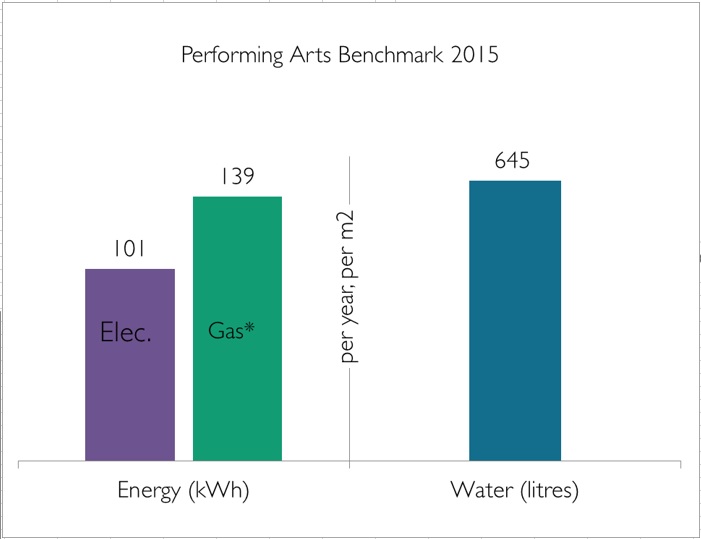- Posted on April 1st, 2015
Benchmarks

Julie’s Bicycle has developed a set of benchmarks to help organisations compare their environmental performance against the industry average for performing arts buildings, museums/galleries, offices and outdoor events. All benchmarks have been developed using data collected by Julie’s Bicycle through Creative Green certifications, Creative Green Tools’ accounts and partner organisations from across the arts and culture sector.
The benchmarks have been created using appropriate ‘relative’ metrics to make them more easily comparable to your organisation whatever its size or scale. The metric is per m2, per year for buildings, and per audience day for festivals. Comparing your environmental performance to these benchmarks using the metrics will give you an understanding of your indicative energy and resource efficiency as compared to the industry average for your sector. The CG Tools will help you compare your impacts to the Julie’s Bicycle benchmarks automatically.
Benchmarks: Offices (2nd Edition, April 2015)
The office benchmark is based on a per m2, per year basis. For a meaningful comparison you should divide 12 months of data across a full year for electricity and gas. Floor area is defined as gross internal floor area, i.e. all spaces and floors within your building.
The vast majority of this data was derived from the Arts Council environmental reporting initiative in 2012/13 and 2013/14; in total 196 offices submitted data.
*Gas has been weather normalised so that it can be compared across different time periods. In order to compare your 12 months of data you must weather normalise your gas consumption for that time period. We perform this calculation in the Creative Green certification and the Julie’s Bicycle Creative IG Tools automatically weather normalise your gas consumption.

Benchmarks: Museums/Galleries and Performing Arts (1st Edition, April 2015)
Due to improved data quality in 2015,Julie’s Bicycle has created two new sub-categories of benchmark:
- ‘Museums and galleries’ – comprising museums, galleries, and art centres
- Performing arts’ – comprising theatres and concert halls
All building benchmarks are based on a per m2, per year basis. For meaningful comparison you should divide 12 months of data across a full year for electricity and gas. Floor area is defined as gross internal floor area i.e. all spaces and floors within your building. Only balconies are excluded.
This data was derived from the Arts Council environmental reporting initiative (2012/13 and 2013/14), ATG Theatres and sMeasure users. Arts Council environmental data comprised 294 venues/cultural buildings.
*Gas has been weather normalised so that it can be compared across different time periods. In order to compare your 12 months of data you must weather normalise your gas consumption for that time period. We perform this calculation in the Creative Green certification and the CG Tools automatically weather normalise your gas consumption.


Benchmarks: Festivals (3rd Edition, November 2014)
All festival benchmarks are based on a per audience day metric. 1 audience day is equal to 1 person visiting the festival for 1 day. E.g. 1 person attending a festival for Friday, Saturday and Sunday = 3 audience days.
Key Facts:
- This is the first time we’ve had sufficient data on recycling and biodiesel consumption which is a testament to the sectors commitment to reducing its impact.
- Diesel consumption includes both red diesel and biodiesel. It includes concession use. Biodiesel is zero-rated for carbon emissions under the assumption that waste-vegetable oil is used.
- Waste is total waste – it includes both waste to landfill and recycled waste. Recycled waste is zero-rated for carbon emissions.
- Water is water consumed only and not waste water.
Sample Size:
- 13 UK festivals spanning 2011, 2012 and 2013.
- In each case the most recent available year of verified data was selected.
- Derived from UK greenfield music events with >20,000 attendance and camping facilities. One festival was included with <20,000 attendees as data aligned well with benchmark median.

